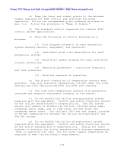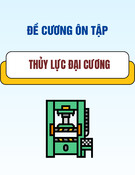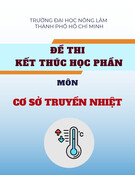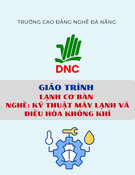
MIL-HDBK-1003/3
APPENDIX D (Continued)
(4) High voltage spikes to motor windings.
(5) Load dependent; poor for multimotor
applications.
(6) Poor input power factor due to SCR converter
section.
D-1.04.3 VSI Design. The VSI drive is very similar to a CSI
drive in that it also uses an SCR converter section to regulate
DC bus voltage. Its inverter section produces a six-step output,
but is not a current regulator like the CSI drive. This drive is
considered a voltage regulator and uses transistors, SCR’s, or
gate turn off thyristors (GTO’s) to generate an adjustable
frequency output to the motor.
a) VSI’s have the following advantages:
(1) Basic simplicity in design.
(2) Applicable to multimotor operations.
(3) Operation not load dependent.
b) As with other types of drives, there are
disadvantages:
(1) Large power harmonic generation back into the
power source.
(2) Poor input power factor due to SCR converter
section.
(3) Cogging below 6 Hz due to square wave output.
(4) Non-regenerative operation.
D-1.04-4 Flux Vector PWM Drives
a) PWM drive technology is still considered new and is
continuously being refined with new power switching devices and
smart 32-bit microprocessors. AC drives have always been limited
to normal torque applications while high torque, low rpm
applications have been the domain of DC drives. This has changed
recently with the introduction of a new breed of PWM drive, the
flux vector drive.
190
Simpo PDF Merge and Split Unregistered Version - http://www.simpopdf.com

MIL-HDBK-1003/3
APPENDIX D (Continued)
b) Flux vector drives use a method of controlling
torque similar to that of DC drive systems, including wide speed
control range with quick response. Flux vector drives have the
same power section as PWM drives, but use a sophisticated closed
loop control from the motor to the drive’s microprocessor. The
motor’s rotor position and speed is monitored in real time via a
resolver or digital encoder to determine and control the motor’s
actual speed, torque, and power produced.
c) By controlling the inverter section in response to
actual load conditions at the motor in a real time mode, superior
torque control can be obtained. The personality of the motor
must be programmed into or learned by the drive in order for it
to run the vector control algorithms. In most cases, special
motors are required due to the torque demands expected of the
motor.
d) The following are advantages of this new drive
technology:
(1) Excellent control of motor speed, torque, and
power.
(2) Quick response to changes in load, speed, and
torque commands.
(3) Ability to provide 100 percent rated torque at
zero speed.
(4) Lower maintenance cost as compared to DC
motors and drives.
e) The following are disadvantages:
(1) Higher initial cost as compared to standard
PWM drives.
(2) Requires special motor in most cases.
(3) Drive setup parameters are complex.
While flux vector technology offers superior performance for
certain special applications, it would be considered "overkill"
for most applications well served by standard PWM drives.
D-1.05 Application of VFD’s to Specific Loads. VFD’s are the
most effective energy savers in pump and fan applications, and
191
Simpo PDF Merge and Split Unregistered Version - http://www.simpopdf.com

MIL-HDBK-1003/3
APPENDIX D (Continued)
they enhance process operations, particularly where flow control
is involved. VFD’s soft start capabilities decrease electrical
stresses and line voltage sags associated with full voltage motor
start-ups, especially when driving high-enertia loads. For the
motor to produce the required torque for the load, the VFD must
have ample current capability to drive the motor. It is
important to note that machine torque is independent of motor
speed and that load horsepower increases linearly with rpm.
Individual load types are as follows:
a) Constant torque loads. Constant torque loads
represent 90 percent of general industrial machines (other than
pumps and fans). Examples of these load types include general
machinery, hoists, conveyors, printing presses, positive
displacement pumps, some mixers and extruders, reciprocating
compressors, as well as rotary compressors.
b) Constant horsepower loads. Constant horsepower
loads are most often found in the machine tool industry and
center driven winder applications. Examples of constant
horsepower loads include winders, core-driven reels, wheel
grinders, large driller machines, lathes, planers, boring
machines, and core extruders.
Traditionally, these loads were considered DC drive
applications only. With high performance flux vector VFD’s now
available, many DC drive applications of this type can be now
handled by VFD’s.
c) Variable torque loads. Variable torque loads are
most often found in variable flow applications, such as fans and
pumps. Examples of applications include fans, centrifugal
blowers, centrifugal pumps, propeller pumps, turbine pumps,
agitators, and axial compressors. VFD’s offer the greatest
opportunity for energy savings when driving these loads because
horsepower varies as the cube of speed and torque varies as
square of speed for these loads. For example, if the motor speed
is reduced 20 percent, motor horsepower is reduced by a cubic
relationship (.8 x .8 x .8), or 51 percent. As such, utilities
often offer subsidies to customers investing in VFD technology
for their applications. Many VFD manufacturers have free
software programs available for customers to calculate and
document potential energy savings by using VFD’s.
D-1.06 Special Applications of VFD’s. If any of the following
operations apply, use extra care in selecting a VFD and its setup
parameters.
192
Simpo PDF Merge and Split Unregistered Version - http://www.simpopdf.com

MIL-HDBK-1003/3
APPENDIX D (Continued)
a) VFD operating more than one motor. The total peak
currents of motor loads under worst operating conditions must be
calculated. The VFD must be sized based on this maximum current
requirement. Additionally, individual motor protection must be
provided here for each motor.
b) Load is spinning or coasting when the VFD is
started. This is very often the case with fan applications.
When a VFD is first started, it begins to operate at a low
frequency and voltage and gradually ramps up to a preset speed.
If the load is already in motion, it will be out of sync with the
VFD. The VFD will attempt to pull the motor down to the lower
frequency, which may require high current levels, usually causing
an overcurrent trip. Because of this, VFD manufacturers offer
drives with an option for synchronization with a spinning load;
this VFD ramps at a different frequency.
c) Power supply source is switched while the VFD is
running. This occurs in many buildings, such as hospitals, where
loads are switched to standby generators in the event of a power
outage. Some drives will ride through a brief power outage while
others may not. If your application is of this type, it must be
reviewed with the drive manufacturer for a final determination of
drive capability.
d) Hard to start load. These are the motors that dim
the lights in the building when you hit the start button.
Remember, the VFD is limited in the amount of
overcurrent it can produce for a given period of time. These
applications may require oversizing of the VFD for higher current
demands.
e) Critical starting or stopping times. Some
applications may require quick starting or emergency stopping of
the load. In either case, high currents will be required of the
drive. Again, oversizing of the VFD may be required.
f) External motor disconnects required between the
motor and the VFD. Service disconnects at motor loads are very
often used for maintenance purposes. Normally, removing a load
from a VFD while operating does not pose a problem for the VFD.
On the other hand, introducing a load to a VFD by closing a motor
disconnect while the VFD is operational can be fatal to the VFD.
When a motor is started at full voltage, as would happen in this
case, high currents are generated, usually about six times the
full load amperes of the motor current. The VFD would see these
193
Simpo PDF Merge and Split Unregistered Version - http://www.simpopdf.com

MIL-HDBK-1003/3
APPENDIX D (Continued)
high currents as being well beyond its capabilities and would go
into a protective trip or fail altogether. A simple solution for
this condition is to interlock the VFD run permissive circuit
with the service disconnects via an auxiliary contact at the
service disconnect. When the disconnect is closed, a permissive
run signal restarts the VFD at low voltage and frequency.
g) Power factor correction capacitors being switched
or existing on the intended motor loads. Switching of power
factor capacitors usually generates power disturbances in the
distribution system. Many VFD’s can and will be affected by
this. Isolation transformers or line reactors may be required
for these applications.
Power factor correction at VFD-powered motor loads
is not necessary as the VFD itself does this by using DC
internally and then inverting it into an AC output to the motor.
VFD manufacturers warn against installing capacitors at the VFD
output.
D-1.07 Sizing VFD’s for the Load. To properly size a VFD for
an application, you must understand the requirements of the load.
The torque ratings are as important as the horsepower ratings.
Every load has distinct torque requirements that vary with the
load’s operation; these torques must be supplied by the motor via
the VFD. You must have a clear understanding of these torques.
a) Breakaway torque: torque required to start a load
in motion (typically greater than the torque required to maintain
motion).
b) Accelerating torque: torque required to bring the
load to operating speed within a given time.
c) Running torque: torque required to keep the load
moving at all speeds.
d) Peak torque: occasional peak torque required by
the load, such as a load being dropped on a conveyor.
e) Holding torque: torque required by the motor when
operating as a brake, such as down hill loads and high inertia
machines.
D-1.08 Guidelines for Matching VFD to Motor. The following
guidelines will help ensure a correct match of VFD and motor:
194
Simpo PDF Merge and Split Unregistered Version - http://www.simpopdf.com

![Hệ thống HVAC và Dehumidifying: Tổng quan [Năm hiện tại]](https://cdn.tailieu.vn/images/document/thumbnail/2012/20120202/luly_meo1/135x160/hvac_and_dehumidifiying_systems_b_split_14_8134.jpg)
![Hệ thống HVAC và Dehumidifying: [Thêm từ mô tả/định tính để tăng CTR]](https://cdn.tailieu.vn/images/document/thumbnail/2012/20120202/luly_meo1/135x160/hvac_and_dehumidifiying_systems_b_split_12_8041.jpg)
![Hệ thống HVAC và Dehumidifying: [Thông tin chi tiết/Hướng dẫn/Lựa chọn]](https://cdn.tailieu.vn/images/document/thumbnail/2012/20120202/luly_meo1/135x160/hvac_and_dehumidifiying_systems_b_split_11_4149.jpg)
![Hệ thống HVAC và hệ thống hút ẩm: [Thông tin chi tiết/Hướng dẫn/Lựa chọn tốt nhất]](https://cdn.tailieu.vn/images/document/thumbnail/2012/20120202/luly_meo1/135x160/hvac_and_dehumidifiying_systems_b_split_10_7992.jpg)
![HVAC và Hệ thống Hút Ẩm: [Thêm thông tin chi tiết để tối ưu SEO]](https://cdn.tailieu.vn/images/document/thumbnail/2012/20120202/luly_meo1/135x160/hvac_and_dehumidifiying_systems_b_split_9_3668.jpg)

![HVAC và Dehumidifying Systems: Hệ thống điều hòa không khí và hút ẩm [chuẩn SEO]](https://cdn.tailieu.vn/images/document/thumbnail/2012/20120202/luly_meo1/135x160/hvac_and_dehumidifiying_systems_b_split_7_2859.jpg)
![HVAC và Dehumidifying Systems: [Mô tả chi tiết/Hướng dẫn/Đánh giá]](https://cdn.tailieu.vn/images/document/thumbnail/2012/20120202/luly_meo1/135x160/hvac_and_dehumidifiying_systems_b_split_6_8164.jpg)
![Hệ thống HVAC và Dehumidifying: [Thông tin chi tiết/Hướng dẫn/Lựa chọn]](https://cdn.tailieu.vn/images/document/thumbnail/2012/20120202/luly_meo1/135x160/hvac_and_dehumidifiying_systems_b_split_5_3816.jpg)
![HVAC và Dehumidifying Systems: [Thêm thông tin chi tiết để tối ưu SEO]](https://cdn.tailieu.vn/images/document/thumbnail/2012/20120202/luly_meo1/135x160/hvac_and_dehumidifiying_systems_b_split_4_7836.jpg)








![Ngân hàng trắc nghiệm Kỹ thuật lạnh ứng dụng: Đề cương [chuẩn nhất]](https://cdn.tailieu.vn/images/document/thumbnail/2025/20251007/kimphuong1001/135x160/25391759827353.jpg)






